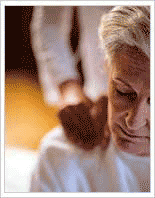Michelle Rasmussen RMT
Massage Therapy
Comprehensive health management

Massage therapy is one of the oldest methods of healing, as the practice of therapeutic massage can be traced back nearly 4,000 years. Statistics from both Health Canada 1 and the American Massage Therapy Association 2 show that millions of North Americans use it today.
Massage therapy refers to a comprehensive health management strategy focusing on the application of various techniques to positively affect the soft tissues and joints of the body. Massage techniques most commonly include pressure and compression, kneading, frictioning, and mobilizing to improve the health and condition of the muscles, tendons, skin, fascia or connective tissue of the body.
Today massage is thought of as a holistic therapy that complements medical treatment. The "Physician's Guide to Therapeutic Massage" shows that massage can decrease pain, improve range of motion, improve mood, aid in the circulation of blood and lymph flow, reduce muscle and joint soreness, and improve sleep.
Is Massage Covered by OHIP?
Massage is NOT covered by OHIP, but many extended health care plans cover Massage
Therapy. You need to check you plan for the specifics
Education:
I attended The Career Development Institute (CDI College) in Thunder Bay, completing a two year condensed diploma program with Honours and Highest Academic Achievement. The Massage Therapy Program is 2000 hours and includes various areas of study including
massage techniques, extensive sciences and anatomy. To become a RMT you have to reach
a standard to practice set by the College of Massage Therapists of Ontario (CMTO) based
on two provincial examinations; one oral practical and one written.
What to Expect on Your First Visit:
On your first appointment you will complete a confidential Health History Form and Consent to Treatment. Next is the interview where you will have a chance to have all your questions answered about any aspect of the treatment. This includes important questions the therapist
needs to ask in able to treat you safely and effectively. The treatment plan will be explainedto you in full. You will have the opportunity to discuss what your areas of concern are and whatyou would like to have treated. You always have the right to stop or change the treatment in any way at any time.
Then it’s on to the treatment Treatments Massage Therapists are trained not only in the art of relaxation massage but in therapeutic treatment. This can range all the way from the aches of a tough workout to a car accident where whiplash occurs ect. Each treatment will start relatively the same as you may have read in the section titled "what to expect on your first treatment".A treatment can be tailored to meet the needs of each individual and can include various different techniqies. The main focus with most treatments is to produce a desired effect; relaxation, increased range of motion, decreased pain, increased circulation and so on.
I use mainly Swedish massage techniques, trigger point therapy and stretch. Swedish Massage: Is the manipulation of tissues using 5 main techniques:
Effleurage-gliding motion used to warm tissues and increase circulation
Pettrisage- kneading movement which is slightly deeper in pressure
Tapotement- tapping-used to relax muscles and increase circulation
Shaking/rocking- used to improve joint health and increase relaxation
Frictions- used only in therapeutic massage to break down adhesion, used in conjuction with heat(hyperthermy)
Trigger Points: Hyper-irritable points in a tight band of musculature-causing discomfort and painTreament of these tender points can include what is called ischemic compression- direct pressure for sustained periodsTreament of these areas can cause discomfort locally and also cause what is called a referral pattern: This can be an unusual feeling which can take on many forms ex ache, numbness, or a tingle that extends from the trigger point to another area of the body while the trigger point is treated.
Stretch-lengthening of a muscleThis can be given with instruciton and demonstration for home care or can also be done within a treatment by the therapist
Most treatments are hands on and will include contact between the client and therapist. Treatments are usually most beneficial with skin on skin contact but desired effects can be reached through clothing, the sheets or around clothing. Your comfort as the client is what is most important during treatment.
1 Health Canada (2003)Health Policy Research Bulletin. Retrieved May 10, 2005, from http://www.hc-sc.gc.ca/iacb-dgiac/arad-draa/english/rmdd/bulletin/mainstream.html#page6
2 American Massage Therapy Association. (2001). Massage Therapy Consumer Fact Sheet